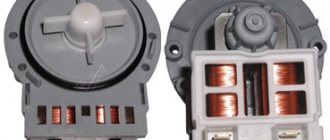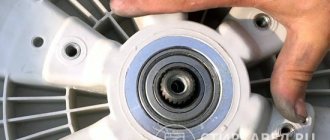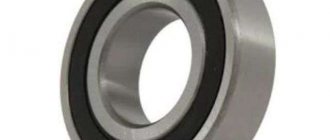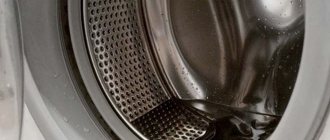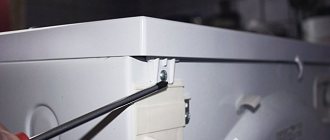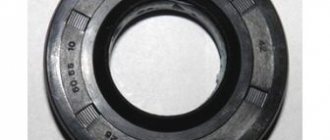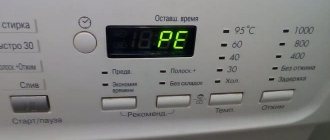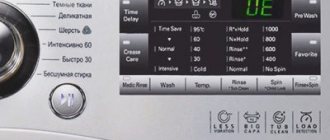The washing machine worked diligently for a long time, but one sad day a strange noise appeared while spinning clothes at high speeds.
Most likely the bearings have worn out and you need to react to this as quickly as possible to avoid wear of the housing. Perhaps nothing bad happened and you only need to lubricate the washing machine drum bearings, which, of course, will significantly extend the life of the equipment. How to do it?
What are the differences between bearings for washing machines?
Bearings are different
not only by the manufacturer, but also by the size and type of material used.
The last parameter determines the main characteristics of the rings, affecting the price, reliability and wear resistance of the part. in washing machines
: metal and plastic.
Interesting materials:
What is the name of the first photo? What is the name of the program for several photos in one? How should I scan photos? How to combine photos into one file on iPhone? How to frame a photo in Photoshop? How to determine the focal length of a lens from a photograph? How to leave a review with a photo on Google? How to disable Photo Mirroring on iPhone iOS 14? How to open photos on Windows 10? How to open HDR photos on iPhone?
Right choice
Before you get started, you need to find out what kind of lubricant to lubricate the bearings with. There are only a few types of lubricants that meet these requirements:
- They are moisture resistant. Since the CM shaft parts are constantly in contact with water, you need a water-repellent bearing lubricant. If water washes away the substance that makes the bearing slide without wear, it will soon wear off.
- They have heat-resistant properties. Hot water in the tank and heating of the shaft during rotation can deprive a cheap lubricant of its properties. Then water will get on the parts and corrosion will begin.
- They should not have an aggressive effect on the rubber. Otherwise, the seal may become stiff, which will lead to water leakage.
- Bearing grease should be thick. Otherwise, it will simply leak out during operation.
Many users are interested in whether it is possible to lubricate bearings with Litol and other automotive lubricants. It is not advisable to use such means. They provide poor protection, so soon you will have to repair the washer again.
Which remedy should you choose?
AMPLIFON is offered by Italian manufacturers MERLONI. This is a moisture-resistant lubricant that is not washed out by water.
Anderol is known for its convenient dosage of 100 grams in jars or syringes for two uses. The product is produced by the manufacturers of Indesit washing machines.
STABURAGS NBU 12 is a water-resistant bearing lubricant that will provide a high level of wear protection. Heat-resistant and resistant to aggressive environments (cleaning solutions).
LIQUI MOLY "Silicon-Fett". Silicone grease for washing machine bearings. It has a thick texture and heat resistance (withstands from -40°C to +200°C). Adheses well, providing a high lubricating effect.
Huskey Lube-O-Seal PTFE Grease. Sticky, homogeneous texture, cannot be washed off even with a water jet. Heat-resistant, withstands from -18°C to +117°C. High corrosion protection.
What is better to lubricate
Some people think that the oil seal is processed first, while the support bearing does not need to be lubricated. This is only true if you purchased the original part.
Note! When processing the oil seal and bearing, never mix lubricants, as they may not be compatible with each other.
Tips for use
Do not overload the detergent hopper. This may cause the detergent hose to become clogged with excess powder. Apply exactly the amount of detergent required for a specific wash program.
Don't forget to clean the drain filter. It is located at the bottom of the machine and collects all large fractions that can harm the pump. If this is not done, then sooner or later it will clog to such a state that water will stop draining from the tank.
What and where to lubricate
Not many people know that bearings require maintenance, but oil seals are also required to be lubricated. Usually the bearings already have grease in them.
If this part is original, made at the manufacturer and bought in a specialized store, then you can put it in the car without additional processing.
Otherwise, questionable quality necessarily requires preliminary care, because cheap materials and lubricants are usually used, among other things. It's better to update it yourself.
Everything needs to be lubricated! Bearings, seals and bushing. But! There should be one lubricant for them. You cannot mix different products.
Algorithm
Modern washing machines are disassembled according to one principle. The main difference is in the design of the tank. For example, LG has a collapsible one. Similar ones are installed in Electrolux, AEG, Samsung. To remove the drum, you need to release the mounting screws.
Cars like "Ariston" or "Indesit" have a solid tank. Replacing the entire structure is quite expensive, so experienced craftsmen use several tricks that allow them to replace or lubricate bearings and other parts without updating the entire tank.
- First of all, you need to open the door slightly and unplug the machine.
- The easiest way to replace pumps in modern devices. They are located at the bottom of the machine and are accessible through the bottom. Therefore, the first thing to do is to put the car on its side or tilt it back and rest it against the wall.
- Remove the front lower panel.
- In many models, shock absorbers and other elements are attached to the bottom. If inspection and repair of defenders is not necessary, it is better not to touch such a bottom, but to remove the face shield. To do this, remove the powder tray (it is secured with self-tapping screws and the water supply valve).
- Remove the control panel.
- Unscrew the screws of the front shield.
- Using a screwdriver, carefully pry off the clamp that holds the cuff, so as not to damage the rubber, and remove it.
- Press the cuff inside the drum and remove the panel.
- Disconnect the wires and set the shield aside.
- Now you can easily disconnect the pump. The most common breakdown in this unit is a blockage or a hole in the pipe (which causes water to leak under the machine) and wear of the armature/motor (which causes vibration when spinning and draining water).
- Clean the pipe and filter from accumulated debris.
- If there is a gap or defect in the motor, replace the pump parts.
After the first stage, access to the shock absorbers/defenders opens. The simplest case is grease abrasion. To restore it, you need to unscrew the parts, extend the rod as much as possible, apply a thick, high-temperature, wear-resistant lubricant to its base and fold and unfold the mechanism several times.
After 10 years of operation, most often the depreciation fails completely. The drum begins to “beat” and make noise during the spin cycle, the machine begins to vibrate and “jump,” and leaks are possible. In such cases, experts recommend replacing the shock absorbers.
Life hack Home craftsmen have found a way to restore defenders and shock absorbers. To do this, you need to remove the rod, as well as the sealing ring-locker. Pour out the “dust” of the gasket and replace it with a piece of leather belt, 2-3 mm thick and approximately 21 mm wide. The section is inserted into the defender body as a ring, with the smooth side facing the body. Next, the gasket together with the rod is treated with a wear-resistant and necessarily viscous lubricant. Machine oil will quickly drain and wear out; such repairs will only last for a couple of months.
Second phase:
- Remove the back panel.
- Remove the weight - the layer that lies on top of the tank.
- Next, remove the clamp that transmits rotation to the tank.
- Using a small screwdriver, press the tabs on the plugs to disconnect the wires from the heating element, tank and motor.
- Unscrew and set aside the motor.
- Disconnect the heating element and water sensors.
- Loosen the fasteners of the tank itself and carefully remove it.
- Remove remaining weight.
After the second stage, the tank is opened, which contains the drum of the washing machine. The detachable one can be easily disassembled, but most modern machines have a one-piece design. It will have to be opened by first treating the seam with sandpaper.
- Cut or unscrew the tank and set aside the top half.
- Remove the gasket or sealant, if there was such a layer.
- Turn the structure over and remove the flywheel on the rear wall of the tank.
Finally the bearing opened. But in order to remove it and lubricate or clean it, you need to free the drum. To do this, place the screw where the flywheel was, and use a hammer to knock the structure out of the “saddle” through the fabric. The pin will come out of the tank and the drum will be separated.
Advice If you have little experience in disassembling washing machines, photograph each significant step and sort the screws so as not to confuse them later. This is especially important when connecting wires.
- Remove the oil seal.
- Use a pipe of suitable diameter to pull out the bearing.
It's easier to throw away a broken part. The collapsible one should be washed in oil or gasoline, and then filled with semi-liquid lubricant. Most often the bearing is simply replaced.
Important If you want your work not to be in vain, buy replacement high-quality German or Polish bearings that are resistant to moisture and high temperature, vibration and wear.
Often the problem is found in the oil seal - the gasket remains without lubrication and breaks or becomes deformed. The faulty part must be replaced with a new one. When assembling, be sure to apply moisture-resistant grease (it is applied to the inner diameter along which the bearing will slide.
Having removed everything, you need to carefully inspect the bushing (the pulley on which the bearing and oil seal are actually put on). All rust and limescale must be wiped off. If scratches are exposed, it is useless to mask and polish them - the bushing will have to be replaced. The same thing happens if the original bearing has become stuck. Trying to cut it with a grinder will only risk the drum. Most likely, trying to free the bushing will damage it - it’s easier to install another one.
If the bearing is non-separable, it can be washed. To do this, the part is spilled with oil, placing a bag and rotating the disk to remove as much dirt as possible.
How to assemble a cut tank The cut tank is covered along the cut with polyurethane or silicone sealant, and then closed with screws, nuts and self-tapping screws strictly along the entire perimeter. If the fastening is not secure, the tank will separate during startup!
According to experts, there is nothing difficult about disassembling a car. It is enough to be careful and know exactly what needs to be done. In practice, inexperienced craftsmen often make mistakes that cause the machine to fail. Miss Clean magazine suggests that novice repairmen start by replacing components that are easier to dismantle, such as pumps or shock absorbers, and try more complex operations first on an old machine that needs to be recycled.
Video: analysis of errors that led to machine breakdown after repair
In general, all operations are accessible; there are enough video tutorials posted on the Internet that will help you cope with repairing a washing machine yourself.
Choosing a lubricant
There are several types of lubricant that are used for bearings and seals. They all have different properties, so you need to choose carefully. The lubricant must meet the following requirements:
- must be moisture resistant. An oil seal is a sealing ring that fits onto a bearing rotating on a shaft, thanks to which water does not penetrate inside the bearing. Therefore, the lubricant on the oil seal should not be washed out with water during operation ;
- be heat resistant. When water is heated to a high temperature and the shaft is heated during rapid rotation of the drum, the oil seal and bearing also heat up, the lubricant must not lose its properties, otherwise water will get inside the bearing;
- should be suitable for rubber and not be aggressive. Due to poor-quality lubrication, the seals can become “stiff” or, on the contrary, become very soft, as a result of which the seal will be compromised;
- should be thick. The grease will not leak out while the machine is in use.
Important! It is better not to use automotive lubricants such as Litol-24, Azmol and others. They are extremely inefficient and very soon you will have to change the bearings in your washing machine.
In service centers to lubricate oil seals, they most often use:
Article on the topic: Why water collects in the drum of a washing machine
- AMPLIFON is an Italian-made waterproof lubricant from MERLONI.
- Anderoll is a special lubricant recommended by Indesit manufacturers, sold in 100-gram jars or in double-portion syringes.
- STABURAGS NBU 12 is another lubricant that is also water and heat resistant.
- LIQUI MOLY “Silicon-Fett” is a German-made silicone grease, sold in 50 gram tubes, quite expensive, but effective for lubricating oil seals.
- Huskey Lube-O-Seal PTFE Grease is a water-resistant lubricant Suitable for both bearings and seals.
Bearings or seal?
Few people ask the question of how to lubricate a bearing in a washing machine, believing that this is not necessary. Most people buy a new set of bearings and seals, and when installing, only lubricate the seal and bushing. As for bearings, they usually already contain lubricant.
If the bearings were purchased from a store that orders original spare parts from the manufacturer, then you can safely put such bearings in the washing machine. In bearings of questionable quality, it is better to renew the lubricant; in most cases, they are filled with cheap low-performance lubricant.
Therefore, the answer to the question of what needs to be lubricated, bearings or oil seals, is this – that’s all. The main thing is that it is one lubricant; mixing different lubricants is unacceptable. In this case, it is better to lubricate only the oil seal and bushing.
Removing the tank
Now let's talk about how to lubricate such important parts of the washing machine. Let us warn you right away that this process is very labor-intensive, since it will require almost complete disassembly of the machine in order to remove the tank and drum from it. Before starting work, disconnect the machine from the water supply, drain and electricity, and then place it so that it can be accessed from all sides. Prepare screwdrivers and pliers, then follow the instructions:
Article on the topic: Should I put laundry in the washing machine?
- remove the top cover of the case by unscrewing the two bolts at the back;
- take out the powder receptacle;
- disconnect the control panel by disconnecting the wires from the board;
- remove the cuff using a slotted screwdriver; to do this, bend the spring and remove the retaining clamp, and tuck the edges of the cuff into the drum;
- remove the bottom panel of the washing machine, which is held on by latches;
- We unscrew the bolts holding the front panel, usually they are located behind the powder receptacle, under the lower and upper panels;
- remove the front wall of the machine body;
Important! Don't forget to disconnect the wires going from the control unit to the hatch locking device.
During this work, you can record the stages with a camera. The pictures will help you assemble the washing machine correctly, without confusing the connections of wires and pipes.
Areas of use
Aerosol and liquid lubricants are used mainly to create a separating layer, to protect and restore rubber seals, and also to lubricate lightly loaded plastic parts.
Greases are less often used as release agents, but they are used in more heavily loaded mechanisms, bearings, hinges, guides, and gears.
The use of silicone grease will help increase the level of electrical insulation or get rid of squeaking in plastic parts or in the brake system.
Industrial Applications
In industry, these materials are also widely used for lubrication of molds, dies, dies, lubrication of knives and sealing jaws in packaging equipment, lubrication of conveyor belts, bearings and guides, lubrication of pneumatic equipment, lubrication of working tools for storage, etc.
One way to protect surfaces from welding sparks and splashes is also to treat them with silicone fluids.
Auto applications
To better understand what silicone lubricant is needed for, let's look at some examples of its most popular automotive applications:
- Restoring the color of plastic parts
- Preventing rubber parts from aging
- For lubrication of disc brake system parts
- Lubricating plastic parts of the car body interior to get rid of squeaks
- Restoring the elasticity of rubber parts and seals
- For lubricating wheel tires during their upcoming long-term storage
- For lubrication of car locks, hinges, hinges
- For lubrication of seat guides, sunroofs, window regulators
- To protect door and hood seals from freezing in winter
- For lubrication of control cables in sheaths
- For lubricating rubber bushings, pipes, engine mounts, etc.
- To improve the electrical insulating properties of high-voltage wires
Silicone grease can ensure absolute sealing of spark plugs before extreme trips.
But silicone lubricant has many uses not only in the automotive field.
Household applications
In domestic conditions, it can be used to lubricate door hinges and locks, window and furniture fittings, treat window rubber seals, and be used for the repair and maintenance of small household appliances (electric shavers, hair clippers, mixers, sewing machines, coffee machines, fishing reels, computer fans), sports simulators.
How to lubricate the oil seal
Now about how to restore the oil seal with your own hands. Of course, a worn oil seal cannot be repaired. Remember a simple rule: if you decide to replace one element, you need to change the entire set if you want to perform high-quality repairs.
It is better to lubricate the oil seal using a syringe. Fill the inner groove of the oil seal and install it in place. All that remains is to assemble the SMA in reverse order.
You learned the best way to lubricate bearings and how to do it yourself. A video on the topic will help you with repairs:
Which drug should I use?
Another question is what means to treat the bearings and seal. Conventional car ones are not suitable due to low efficiency. We need special compounds with special characteristics.
- Moisture resistance. The drum shaft is constantly in contact with water, so the lubricant must have a water-repellent effect. Without such protection, the bearing will gradually lose its factory sliding filler and quickly collapse.
- Heat resistance. At high temperature conditions, the water in the tank heats up, and along with it the drum itself with the shaft. If the product does not “work” in a hot environment, it will lose its properties, allow moisture to pass through, and corrosion will begin.
- Can be used on rubber surfaces. Too aggressive compounds will lead to hardening of the seal, which will disrupt the tightness of the unit and accelerate its destruction.
- Thick consistency. Liquid lubricants do not adhere well to the surface and leak out during operation of the machine.
Summarize
Despite the fact that the work of repairing automatic machines is not easy and quite labor-intensive, if you have free time, it is better to do it yourself. This will save money, and it’s not for nothing that they said from time immemorial: “If you want to do it well, do it yourself.” But before you disassemble the bearing, you should soberly assess your strength. Remember that a normal technician will not assemble the unit you disassembled.
We hope that today's article was useful to the reader. If you have any questions while reading it, you can ask them in the comments below. The editors of electric-220.ru will be happy to answer them. If you have experience in producing such work, please share it with novice home craftsmen. Write, communicate, ask. And finally, according to the already established good tradition, we bring to your attention a short but quite informative video on today’s topic.
Stages of work
You need to start by disassembling the washing machine and removing the bearings. For any brand and model, the disassembly principle is almost the same.
Start by removing the panels
Remove the top cover by removing the screws from the back that hold it in place. Then push it forward and out of the way.
Remove all the screws around the perimeter of the back panel that hold it in place. Now move to the front of the case.
- Pull out the detergent tray by pressing the lock in the center.
- Unscrew the bolts that are located behind the tray, as well as on the opposite side of the control panel.
- Release the plastic latches and remove the control panel. If you decide to unfasten all connections, take photographs of their locations in advance.
- Open the hatch door. Bend the cuff and remove the clamp. Place the sealing rubber inside the tank.
- Remove the two screws holding the hatch lock. Unfasten the wiring from the lock.
- Unscrew all screws holding the front panel.
Remove parts from top of tank
Remove the upper counterweight by unscrewing the mounting bolts.
Now you need to get the powder receptacle. Using pliers, loosen the clamp that secures the pipe to the cuvette. Disconnect the pipe. The filler valve hoses are also attached to the powder receiver. You can disconnect them, but it is easier to remove them together with the valve. For this:
- Unscrew the bolt on the back wall that holds the valve.
- Disconnect the wiring from the valve and remove it from the housing along with the cuvette.
Also unfasten the pressure switch hose that is attached to the tank.
Move to the front of the body
Remove the front tank counterweights by unscrewing the bolts.
If the heating element of your washing machine is located in front under the tank, disconnect its connectors. Then, using wire cutters, remove the wiring clamps and remove it from the tank. Unscrew the screw of the drain pipe clamp. Remove it from the tank.
Be careful, water may spill out of the spigot.
Disassemble from behind
Remove the drive belt by pulling it to the side and turning the pulley.
If the heating element of the car is located at the rear, unfasten its wiring, as well as the engine connectors. Now unscrew the motor bolts and pull it out of the housing.
Unclench the plastic clip and unfasten the pressure chamber that is attached to the tank. Unscrew the shock absorber bolts. Lift the tank and remove it from the hooks, pulling it out of the housing.
Place the tank on a flat surface. Remove the sealing rubber of the hatch by removing the inner clamp. Turn the tank over and remove the pulley by unscrewing the central bolt. Pre-secure it with a wooden plank.
Separate the two parts of the tank by unscrewing the screws around the perimeter. Take out the drum. Now you get to the bearings. Now you will learn how to properly lubricate a bearing in a washing machine.
Finish work
Remove the bearings from the tank. To do this, pry the oil seal with a screwdriver and pull it out. Place a chisel on the outer race of the bearing and, tapping with a hammer, knock it out of the tank. Do the same with the second element.
If you have decided which bearing lubricant is best to choose, then after cleaning you need to remove the protective cover of the part. The product is placed inside.
But how is a non-separable, sealed bearing lubricated?
- Take WD-40, spray the parts with it and wipe well with a rag.
- After cleaning, you need to open the lid, but it does not work.
- Fill the inner ring of the part with a plastic bag.
- Take a tube of lubricant and cut the neck so that it is equal to the diameter of the inner ring of the bearing.
- Place the tube on the inner race and squeeze out the lubricant until it starts to come out from the opposite side.
- Then start rolling the bag around inside to distribute the lubricant. If you were wondering whether sealed bearings need to be lubricated, now you know what is necessary and possible.
- Remove any excess. Reinstall the part.
